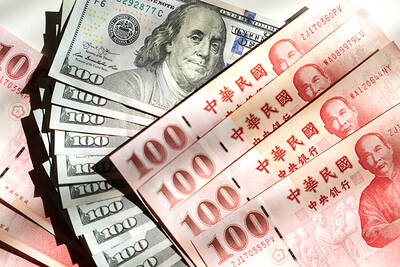South Korea replaced Japan as the largest trade deficit country for Taiwan in the first 10 months of this year, with Seoul the main supplier of electronic components to Taipei’s artificial intelligence (AI) developers, the Ministry of Finance said on Thursday last week.
During the January-to-October period, Taiwan’s trade deficit with South Korea rose to US$18.1 billion, surpassing the US$10.2 billion deficit for all of last year and topping the US$16.7 billion deficit with Japan, the ministry said.
The ministry said the deficit with South Korea has been rising because the country supplies a large volume of DRAM chips to Taiwan’s AI-related goods producers, while Taiwan and South Korea are close partners in the global supply chain, it added.

Photo: EPA-EFE / YONHAP
Recently, South Korea-based SK Hynix Inc, the second-largest DRAM brand in the world, said it would work with Taiwan Semiconductor Manufacturing Co (台積電) to develop the next generation of high bandwidth memory chips, with both companies supplying US-based AI chip designer Nvidia Corp.
ICs were the largest category of exports from South Korea to Taiwan in the 10-month period, with a value of US$23.6 billion, ahead of oil refinery items at US$1.1 billion, cyclic hydrocarbon at US$900 million, computer components at US$900 million and semiconductor production equipment at US$600 million, the ministry said.
Over the period, ICs were the largest source of Taiwan’s trade deficit with South Korea with a value of US$12.9 billion, accounting for about 71.3 percent of Taiwan’s total trade deficit ahead of oil refinery items at US$800 million and computer components at US$700 million, it said.
Taiwan sold US$16.8 billion of goods to South Korea in the 10 month period and bought US$34.9 billion worth of South Korean-made merchandise.
South Korea was the fifth-largest export market for Taiwan, trailing China and Hong Kong, the US, Japan, and Singapore, but the fourth-largest supplier to Taiwan following China and Hong Kong, the US, and Japan.

MARKET LEADERSHIP: Investors are flocking to Nvidia, drawn by the company’s long-term fundamntals, dominant position in the AI sector, and pricing and margin power Two years after Nvidia Corp made history by becoming the first chipmaker to achieve a US$1 trillion market capitalization, an even more remarkable milestone is within its grasp: becoming the first company to reach US$4 trillion. After the emergence of China’s DeepSeek (深度求索) sent the stock plunging earlier this year and stoked concerns that outlays on artificial intelligence (AI) infrastructure were set to slow, Nvidia shares have rallied back to a record. The company’s biggest customers remain full steam ahead on spending, much of which is flowing to its computing systems. Microsoft Corp, Meta Platforms Inc, Amazon.com Inc and Alphabet Inc are

Luxury fashion powerhouse Prada SpA has acknowledged the ancient Indian roots of its new sandal design after the debut of the open-toe footwear sparked a furor among Indian artisans and politicians thousands of miles from the catwalk in Italy. Images from Prada’s fashion show in Milan last weekend showed models wearing leather sandals with a braided design that resembled handmade Kolhapuri slippers with designs dating back to the 12th century. A wave of criticism in the media and from lawmakers followed over the Italian brand’s lack of public acknowledgement of the Indian sandal design, which is named after a city in the

The US overtaking China as Taiwan’s top export destination could boost industrial development and wage growth, given the US is a high-income economy, an economist said yesterday. However, Taiwan still needs to diversify its export markets due to the unpredictability of US President Donald Trump’s administration, said Chiou Jiunn-rong (邱俊榮), an economics professor at National Central University. Taiwan’s exports soared to a record US$51.74 billion last month, driven by strong demand for artificial intelligence (AI) products and continued orders, with information and communication technology (ICT) and audio/video products leading all sectors. The US reclaimed its position as Taiwan’s top export market, accounting for

INVESTOR RESILIENCE? An analyst said that despite near-term pressures, foreign investors tend to view NT dollar strength as a positive signal for valuation multiples Morgan Stanley has flagged a potential 10 percent revenue decline for Taiwan’s tech hardware sector this year, as a sharp appreciation of the New Taiwan dollar begins to dent the earnings power of major exporters. In what appears to be the first such warning from a major foreign brokerage, the US investment bank said the currency’s strength — fueled by foreign capital inflows and expectations of US interest rate cuts — is compressing profit margins for manufacturers with heavy exposure to US dollar-denominated revenues. The local currency has surged about 10 percent against the greenback over the past quarter and yesterday breached